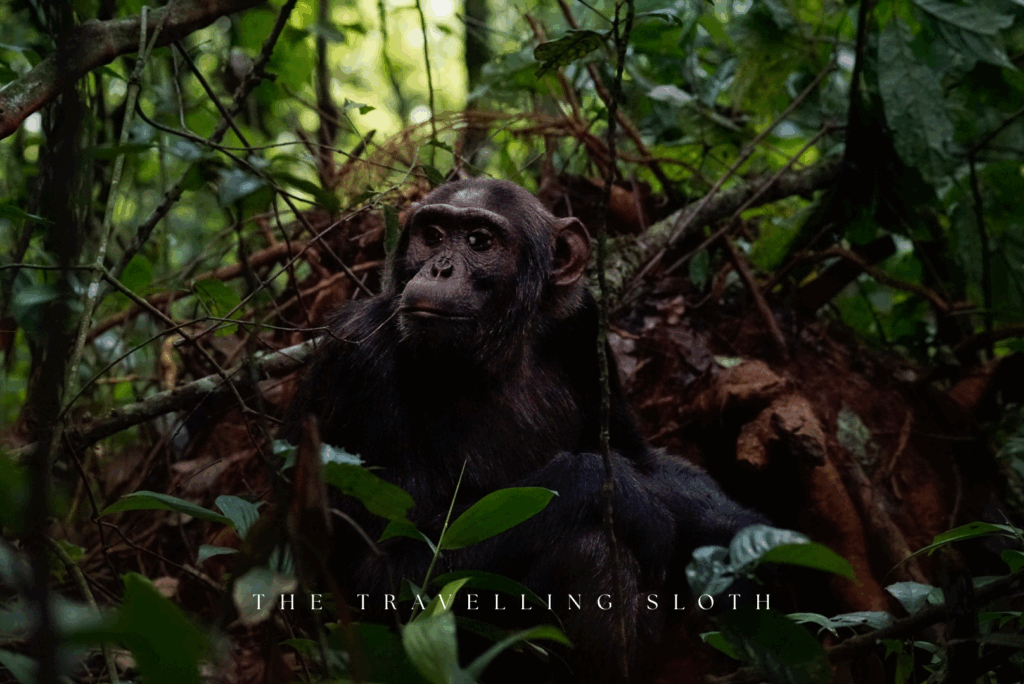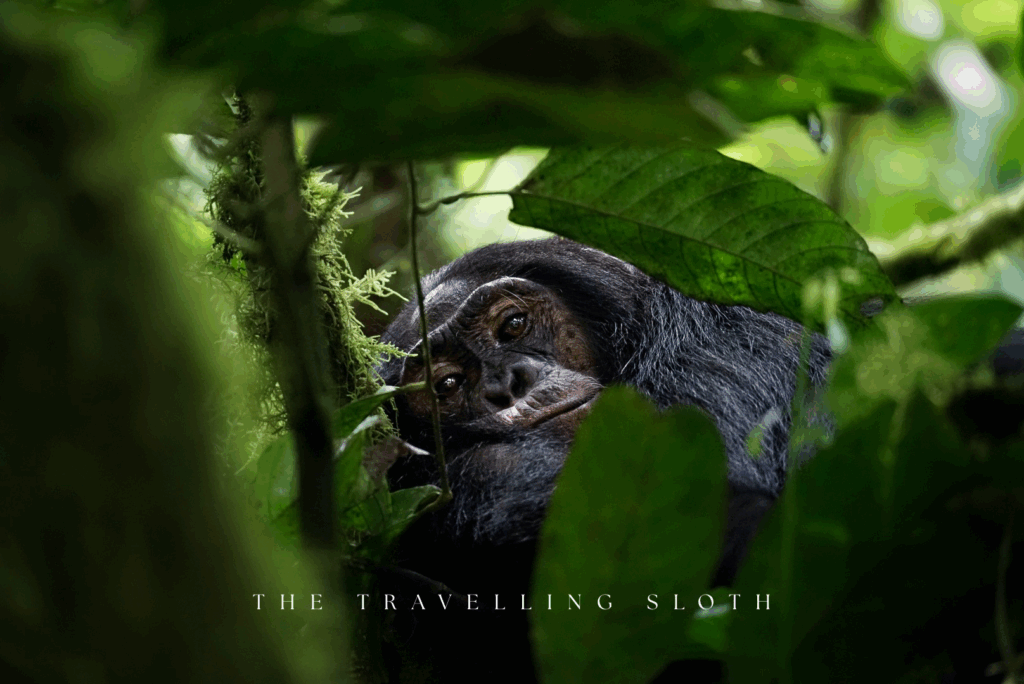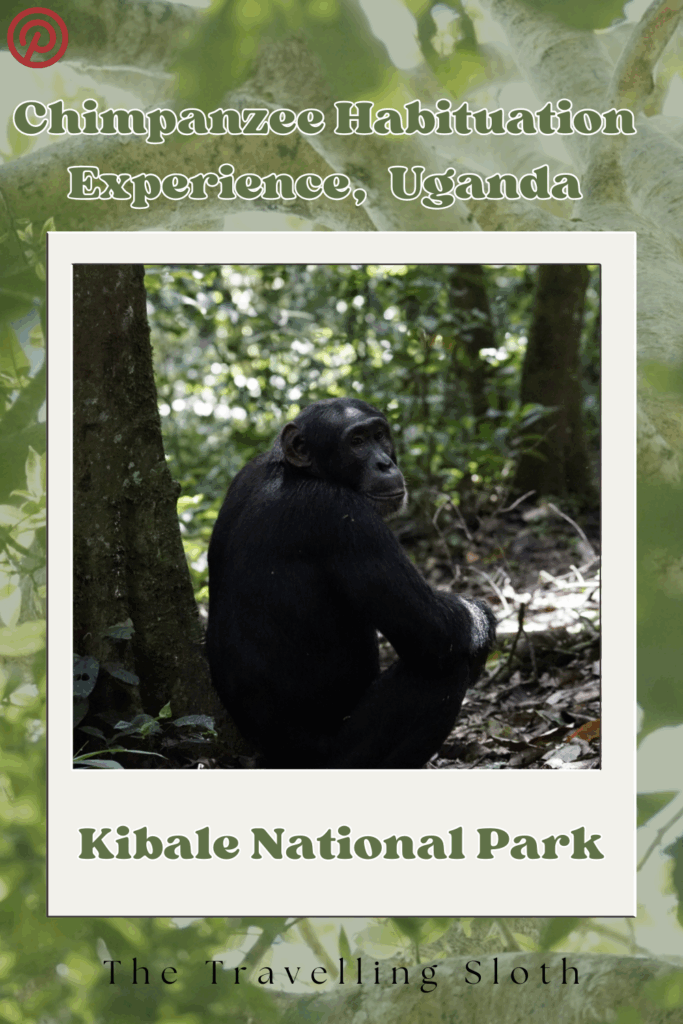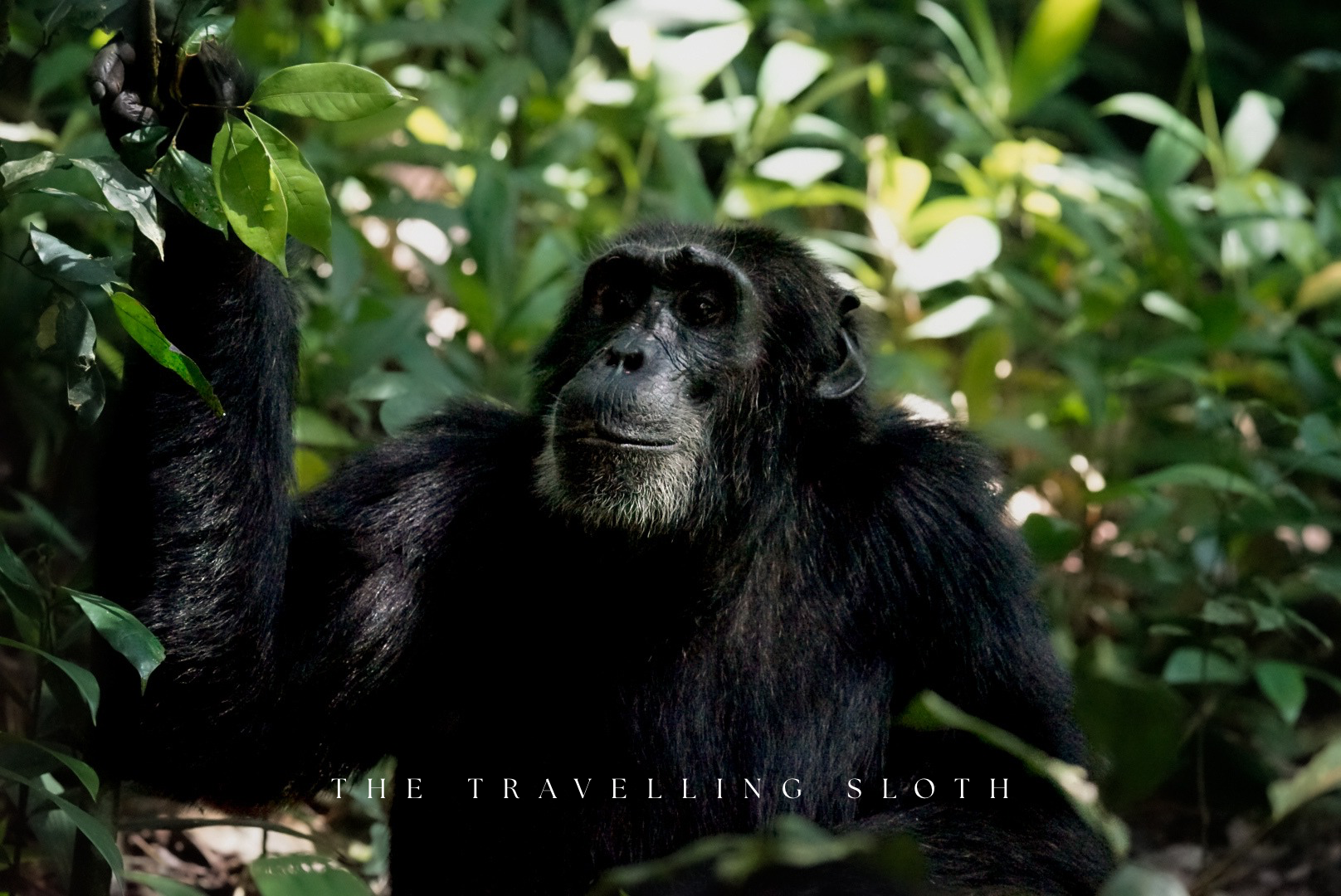I am assuming you have landed here because you want to have an once-in-a-lifetime animal encounter or maybe curious about Chimpanzee Habituation. Have you ever watched Chimp Empire on Netflix and wondered what it would be like to experience that for yourself? Did you know it was filmed in Kibale National Park, Uganda? It’s also where Jane Goodall spent decades studying our closest relatives. Ever fancied your own Jane Goodall experience? I would strongly suggest you go on a Chimpanzee Trek in the forests of Kibale!
Kibale National Park is known for its dense population of primates, giving visitors a 95% chance of seeing them here. It’s certainly an amazing place to observe chimpanzees in their natural habitat. The whole reason behind our trip to Uganda was to dive in and experience some incredible wildlife, and one of these experiences would be chimpanzee tracking. From the start to the end of the day, I was in complete amazement so join me as I relive the day, sharing insights and tips to inspire your own chimpanzee visit in Uganda!
Chimpanzee Habituation Experience (CHEX) vs Chimpanzee Trekking
When researching the different options, you’ll see lots of chatter about chimpanzee habituation or chimpanzee trekking. They are similar that you’ll get to have encounters with chimpanzees in their natural habitat, but they are vastly different in terms of the experiences you may have. We opted for the CHEX so let’s dive into why chimpanzee habituation is so distinct. Chimpanzee habituation is a fascinating process that offers a deeper understanding of these intelligent creatures. This section dives into what makes habituation distinct from chimpanzee trekking and highlights the conservation efforts at its core. Ultimately, while trekking offers a quick look, habituation provides an in-depth understanding of chimpanzee behavior and ecology.

Chimpanzee Trekking
Permits cost USD$250 including national park fees and the guides.
Chimpanzee trekking typically involves guided tours where visitors observe chimps at a safe distance. These treks are usually quicker, providing a glimpse into the chimps’ lives without disturbing their natural routines. Your day starts at 0800hrs at the briefing point and you begin your trek to where the UWA trackers found the chimpanzees. You spend approximately an hour with them before heading back to the visitor center. Depending on the groups, the chimpanzees you visit will probably be one of the groups that has already been habituated and are accustomed to human presence. There are a couple of times you are able to do the chimpanzee trekking – a morning or afternoon session.
Chimpanzee Habituation Experience (CHEX)
Permits cost USD$300 including national park fees and the guides.
If chimpanzee trekking gives you a glimpse into the lives of our closest relatives, chimpanzee habituation offers something much richer… an immersive, behind-the-scenes experience that few travellers ever get. Unlike the standard chimp treks, the chimpanzee habituation experience (CHEX) in Kibale National Park lets you spend up to four hours with a community of wild/semi wild chimpanzees as they go about their day. But be warned, it starts really early. At 6:30 AM, you’ll gather for a briefing before heading out with expert guides to the approximate area where the chimps nested the night before. There are no pre-set paths here. You’re not just meeting the trackers… you are the trackers.
What follows is a thrilling, slow-paced pursuit through dense forest, listening for calls, scanning treetops, and reading signs of movement. When you finally find the chimps, the real experience begins. You’ll observe them waking, feeding, socializing, grooming, and if you’re lucky, building nests for an afternoon nap.
This isn’t just wildlife viewing. It’s a key part of the conservation process, where researchers and rangers slowly build trust with wild chimpanzee communities, helping them grow comfortable with human presence for long-term scientific study and eco-tourism. Guides will share fascinating insights into chimpanzee behavior, forest ecology, and the delicate balance between tourism and conservation.
By the end of the day, you’ll walk away with muddy boots, a memory card full of once-in-a-lifetime moments, and a deeper respect for the complex social lives of chimpanzees. More than just an activity, chimpanzee habituation is a meaningful contribution to primate conservation in Uganda, and an eye-opening reminder of how connected we are to the wild.

Understanding the process and its importance
Chimpanzee habituation involves several stages, starting with the identification of a chimpanzee group. Researchers and guides spend extended periods in the forest, slowly gaining the trust of these primates. This process takes years to establish. Here you may be joined by a team of researchers who are studying specific behaviours of the chimpanzees. The team of researchers we met during our time was studying the social dynamic of the chimpanzees, and gut health of the infants throughout the year.
- Conservation Efforts: Conservation efforts focus on minimizing human impact and promoting research that enhances understanding of these primates. 10% of the permit fees goes to the local communities surrounding the forest. It helps incentivize the locals to help protect the chimpanzees. It also helps protect chimpanzees from poaching and habitat loss. Habituation limits visitor numbers to protect chimpanzee welfare.
- Educational Opportunities: The guides are open to talk about the challenges faced by the chimpanzees and the difficulties that comes with conservation. You also see how the behaviours of the chimpanzees change throughout the day and it is truly fascinating. Education initiatives raise awareness about protecting chimpanzees and their habitats.
- Tourism: Sustainable tourism programs can be developed, contributing to local economies. The habituation process serves as a model for sustainable tourism, demonstrating how responsible travel can contribute to conservation goals while offering enriching experiences to adventurous visitors.
By fostering a deeper understanding, habituation plays a central role in safeguarding these incredible animals for future generations.
Planning Your Kibale Adventure
Planning your adventure to Kibale involves more than just arriving at the park. This section provides insights on securing permits, preparing for a day of activities, and packing essentials to ensure a memorable and conservation-focused experience.

Securing Chimpanzee Habituation or Trekking Permits
Securing chimp trekking permits is a vital step in planning your visit to Kibale. These permits regulate visitor numbers and ensure a responsible approach to wildlife tourism. As a foreigner and non-Ugandan resident, you are unable to book the permits directly through the Uganda Wildlife Authority (UWA). You will have to go through a tour operator who will book and handle all the paperwork related to the permits on your behalf.
A couple of things worth noting:
- Permits are limited and should be booked in advance. There are a limited number of permits available per day for both CHEX and Trekking. The UWA office is closed over the weekend so don’t wait until the last minute to try and secure your permits! Majority of the time, permits will have to be booked through the UWA head office in Kampala.
-
Consider visiting during the dry season for easier trekking conditions. We did this during the shouldering month and we lucked out that it didn’t rain on our habituation day. However, it rained like cats and dogs the other days. I am sure the chimpanzees would probably be hiding from the rain so you might have a completely different experience.
-
Yes, the permit fees are extremely high but they go towards supporting conservation efforts, contributing to the preservation of Uganda’s wildlife.
Okay… but how did I secure my permits?
If there’s one thing you should know about me by now, it’s that I am the Queen of last-minute planning… and arranging our chimpanzee trekking permits was no exception. We decided on a Thursday that we had to do it… only to discover we couldn’t buy the permits online, and that they had to be collected in person from the UWA Headquarters in Kampala, which obviously is closed on weekends!
Enter our stroke of luck: while in Rwanda, we met a tour guide who gave us the contact of a guy in Uganda who could help. And that’s how we met Ezra from Private Trip Uganda. When I say this man delivered… I mean he delivered.
Ezra not only sorted our permits at lightning speed (despite our last-minute chaos), but also booked us what I would argue was the best lodge of our entire East Africa trip. More on this lodge later because it truly deserves a post on its own.
📞 Ezra – Private Trip Uganda: +256 7098 83164
I rarely recommend people, but Ezra was a lifesaver. If you reach out to him, tell him Caroline + Owen send their regards… and maybe a thank-you on my behalf!

Preparing for A Full Days Activities
Preparing for a day of chimpanzee habituation ensures you make the most of this unique experience. Early mornings are common, so be ready for a full day in the park. Wear comfortable clothing, such as long sleeves and trousers, to protect against insects and branches. I used a pair of gaters to protect me from any potential safari ants. There were a lot of velcro-plants and we kept picking up its seeds!
It is really humid in the forest so bring water to keep yourself hydrated. Depending on where the chimpanzees are, you may be hiking for several hours or for 30mins! With good physical preparation and gear, you can focus on the incredible sights and sounds around you. The terrain was relatively flat with some inclines/declines and thick bush but considering that I am lacking an ACL, it wasn’t too challenging.
Packing Essentials
Lightweight, moisture-wicking clothing that dries quickly is ideal. Sturdy, waterproof boots are necessary for trekking through diverse terrain. Eco-friendly insect repellent and sunscreen help protect both you and the environment. Don’t forget a small backpack to carry your essentials comfortably. With the right gear, you’re ready to enjoy a fulfilling day immersed in the wonders of Uganda’s wildlife.
Packing for your nature tourism adventure in Kibale requires careful consideration. Ensuring you’re well-equipped enhances your experience and supports conservation-focused travel.
A Day in the Life of Chimpanzee Habituation Experience
CHEX in Kibale can be a full-day adventure that requires preparation, enthusiasm and the right attitude.
Morning Briefing
You will meet bright and early at the Kanyanchu Visitors Center at 0630hrs to begin your briefing. You will sign yourself in with the clerk, show your permits. The guide will explain briefly the rules, do’s/don’ts when encountering with the chimpanzees. Soon after, you and the guides will head off to the starting point. If you drove your own vehicle there, you will be driving to the starting point.
Note: we didn’t realised but you need to show the original printed permits. Not copies or e-copies. The clerk didn’t give us a hard time about it, and we worked together to send him what we had.
The excitement of what lies ahead keeps energy levels high, despite the early start.

Trekking Through the Forest
The forest trek is an adventure in itself, as you navigate through the foliage and uneven terrain. Each step brings you closer to the chimpanzees. The paths were well trodded – assumingely from both humans and chimps! We kept quiet during the trek so we could listen to nature’s symphony. You’ll hear the chirps and songs of birds in the morning and if you’re lucky, you may also hear the calls of the Eastern Colobus monkeys… maybe you might even spot one! Our guide listened out for the chimp calls and looked at any fresh imprint to identify their movements. It was truly amazing how he found them.
Understanding Chimpanzee Behavior
Understanding chimpanzee behavior is a highlight of the habituation experience. I would probably say that if you want to understand their behaviours and observe their social dynamics, then the CHEX would be right up your alley. We had learnt so much from our guide who had spent over a decade with these animals so the following section will dive into a brief overview of what we had learnt from Alex. Maybe it may even deepen your appreciation for these remarkable primates!
Learning Different Chimpanzee Names
During habituation, you’ll encounter chimpanzees with distinct identities. Alex shared some of the names of the chimpanzees we encountered and their stories. It really gives you the realization that they really aren’t that different to us. Here are some of the chimps we saw and their stories.

- Queen – a baby chimpanzee we had spent some time with. She was born the same year as the passing of Queen Elizabeth (hence the name). Extremely playful but seems to yearn for her mother’s attention.
- Baboo – Queen’s mother. She was in heat when we encountered her and was trying to get frisky, a lot. Unfortunately, she had 3 other babies prior to Queen (none had survived). So you wonder if she tries to get pregnant because of her previous experiences.
- Escort – a solitary male chimp. We usually found Escort by himself, away from the rest though not too far. If you watch Chimp Empire, you’ll learn that 10-15 are usually a difficult time for males and it held true for Escort (10 years old).
- One Eye – his Ugandan name is a lot nicer than its English translation but the reason to the name is that One Eye is blind in their left eye (from birth).
- Bent Back – similar to One Eye, his Ugandan name sounds a lot nicer. His hunchback appearance coined his name.
- Hook – if I am not mistaken was his name. He was a rescue whose left hand was caught in a trap set by the local community some time ago. The park wasn’t sure if he would make it but he did! You will notice that his demeanor is a lot more timid and wary of humans. Completely understandable considering his experience.
Connecting names with behaviors creates a more intimate experience, enhancing your journey into the chimps’ world. Recognizing them as individuals enriches your appreciation of their complex social structures and it becomes slightly easier to identify them when you see them again in another part of the forest.

Observing Social Dynamics
In the wild, chimpanzees exhibit intricate social dynamics. Once again, Chimp Empire will show you how complex some of these behaviours and dynamics are. Observing these interactions during habituation provides valuable insights into their community life. These dynamics highlight the complexity of chimpanzee societies, reminding us of our own social behaviors. By understanding these patterns, you gain a newfound respect for their intelligence and adaptability.
-
Hierarchy and Leadership: Witness the roles of alpha males and their influence. It is interesting because you can identify an Alpha (or maybe the 2nd or 3rd Alpha) purely by how they carry themselves. It comes across as more serious and calmer.
-
Bonding and Grooming: Grooming is essential for building social bonds in the primate world. It is how families bond and how social hierarchy can be perceived.
-
Communication: Listen to vocalizations and gestures that facilitate interaction. During our visit, food was scarce so when part of the troop found food, you could hear the calls echoing through the forest. They would also communicate through “chimp drums” – by banging on part of the tree to communicate dominance or otherwise.
Recognizing Individual Behaviors
Each chimpanzee displays unique behaviors that reflect their personality, like humans. Recognizing these individual quirks is a captivating part of the habituation experience.
-
Playfulness: Some chimps are more playful, engaging with others in lively antics.
-
Curiosity: Watch as curious chimps explore their surroundings, showcasing their intelligence.
-
Leadership: Observe the confident demeanor of leaders guiding the group.
These individual behaviors underscore the diversity within chimpanzee communities. They offer a glimpse into the lives of these fascinating creatures, deepening your connection to their world.

Changes in Behaviour Throughout the Day
In the early morning, most of the chimpanzees were high up in the trees, likely not far from their overnight nests. During the cooler hours of the day, they were more socially active feeding, foraging, and grooming each other in small social groups. As the sun climbed and the heat intensified, the chimpanzees gradually descended from the canopy to the forest floor. Many sought shade under the dense foliage, resting or slowly moving through the undergrowth. By midday, some had even begun constructing fresh nests for a relaxed afternoon siesta.
I hadn’t realized just how much time chimpanzees spend in the treetops. Although they’re known for their ability to swing from branch to branch (a behavior called brachiation), I learned they often travel on the ground especially when covering long distances. Watching them move through the forest on foot was one of the most surprising and fascinating parts of the experience. They actually got incredibly close!
Reflections on CHEX
Reflecting on my chimpanzee habituation experience, I gained valuable insights and a deeper appreciation for wildlife. Here are my thoughts and hopes for future explorations. The adventure taught me several important lessons about wildlife and conservation. Here are some key takeaways:

- Patience Pays Off: Observing wildlife requires patience and respect. If the chimpanzees want to spend their days up in the canopies and not come down, it is just part of nature! Alex, our guide said that on the previous day, they had to trek for 6 hrs before finding the chimpanzees and even so they could only find 3 chimpanzees. Whereas we found a whole troop!
- Personal Growth: The experience enriched my understanding of nature. You would think that you could only get these types of experiences by watching Nat Geo or a David Attenborough documentary but that’s far from the truth. I gained a deeper understanding and appreciation spending time with our closest cousins. It is such a shame how habitat loss and poaching can almost wipe them from the world as we know it.
- Delicate Balance: Conservation efforts must balance tourism with wildlife protection. While not everyone would get an opportunity like this, we must also use our platform to speak up for the wildlife. If more people understood and appreciated animals more, then we are in a much better position to protect them.
- Do CHEX if you’re a photographer or a keen wildlife enthusiast: as an avid wildlife photographer, spending time with the chimpanzees gave me a lot more of an opportunity to learn, photograph and have a glimpse into their lives. My husband is a wildlife enthusiast and he was absolutely amazed observing their behaviours and having such an intimate encounter with the chimpanzees.
- Do the Chimpanzee Trekking if you’d just like to see them: CHEX is not for everyone, it is 4 hrs of spending with the chimpanzees. Some people I know who have done this experience thought it was enough to do the chimpanzee trekking. So weigh how much time you would like to see these animals.

Inspiring Others to Explore
One of my biggest hopes through sharing these stories is to inspire others to head out on their own wildlife adventures and Uganda is honestly one of the best places to start. Between tracking wild chimpanzees in the forest and coming face-to-face with mountain gorillas, the experiences here are completely unmatched. Every trip is a chance to learn something new, challenge yourself, and connect with the world in a deeper way. And the best part? Your visit directly supports conservation efforts and local communities, so your adventure also gives back.


Leave a Reply